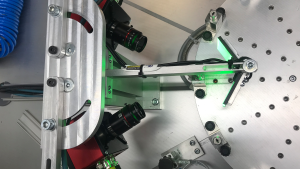Potential Industry Sectors for Smart Cameras
Use cases and challenges
Intelligent cameras are revolutionizing the way various Industry sectors work. Every Industry has its own challenges to overcome, where smart cameras can be a great support. Find out in which Industry Smart Cameras are already being used, what tasks they solve and what challenges they face.
Manufacturing
🏭 In the manufacturing industry, intelligent industrial cameras are used for quality control, inspection and monitoring of production lines. They can detect defects, measure distances and monitor the production process to ensure that products are manufactured to the required standards.
❗️ The challenges for smart cameras in the manufacturing industry are that the cameras have to withstand harsh industrial environments and work in high-speed production lines. This means that the hardware of the smart cameras must be very robust and insensitive under these circumstances.
Logistics and transportation
🚚 In the logistics and transportation industry, intelligent cameras are used to track and identify freight, monitor traffic and ensure the safety of drivers and passengers. They can also be used to monitor the condition of vehicles and equipment.
❗️ The cameras must be able to withstand the effects of the weather and work under different lighting conditions. Lighting is enormously important when it comes to Machine Vision.
Security & monitoring
📹 Another Industry in which smart cameras are frequently used is the security and surveillance industry. Smart cameras are used to monitor public spaces, identify and track people and ensure the security of buildings and critical infrastructure.
❗️ The biggest challenge in this Industry is that the cameras must be able to identify and track people in crowded and busy environments.
Agriculture
🌳 In agriculture, smart cameras can be attached to tractors to capture images of crops, which can then be analyzed to detect problems such as pests, diseases or nutrient deficiencies. However, they are also able to map fields and create detailed images of the terrain that can be used to control planting, fertilization and harvesting.
❗️ One challenge in agriculture is similar to the one already mentioned. The intelligent cameras have to work in all weather conditions and cope with changing light conditions. The power supply also poses a challenge.
Despite all these challenges, intelligent cameras are proving to be a valuable tool for improving efficiency, reducing costs and ensuring the safety of people and equipment. As the technology continues to develop, it is expected that even more industries will use this technology to improve their operations and processes.
Other contributions:

Release Update V5.4.0
The release update V5.4.0 is here! A major dashboard update, minor bug fixes and the integration of persistent variables are included.

Finally: The new VIU2 PoE camera is here!
The VIU2 PoE camera is here! You can find out why PoE is an important feature in this article.

Finally: The new VIU2 PoE camera is here!
The VIU2 PoE camera is here! You can find out why PoE is an important feature in this article.

